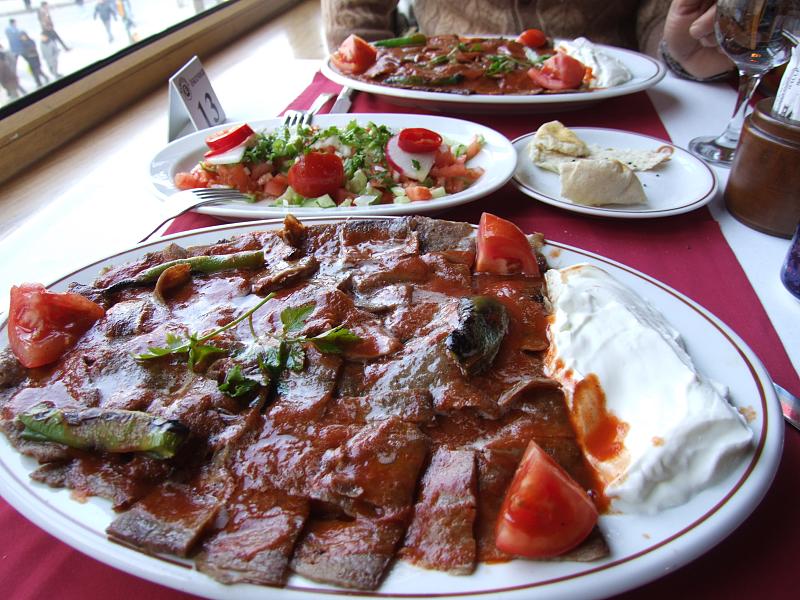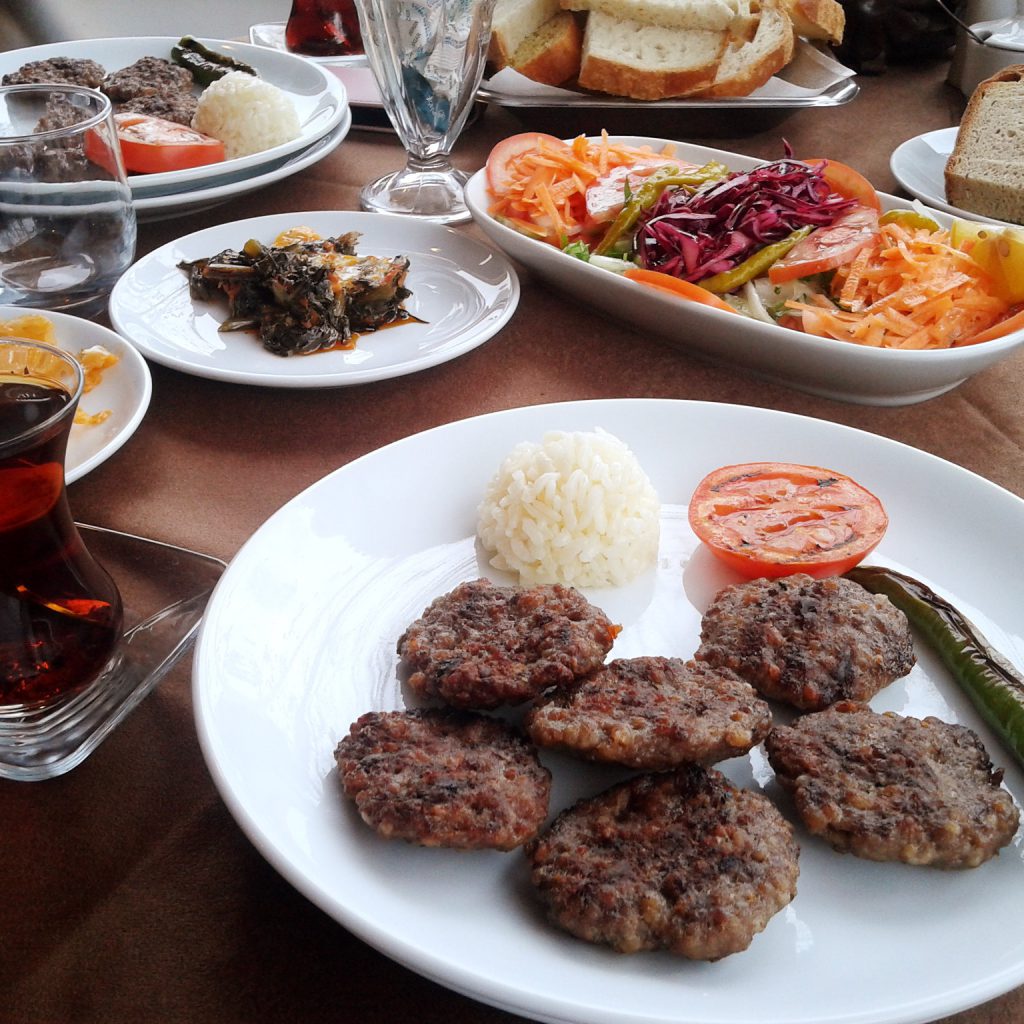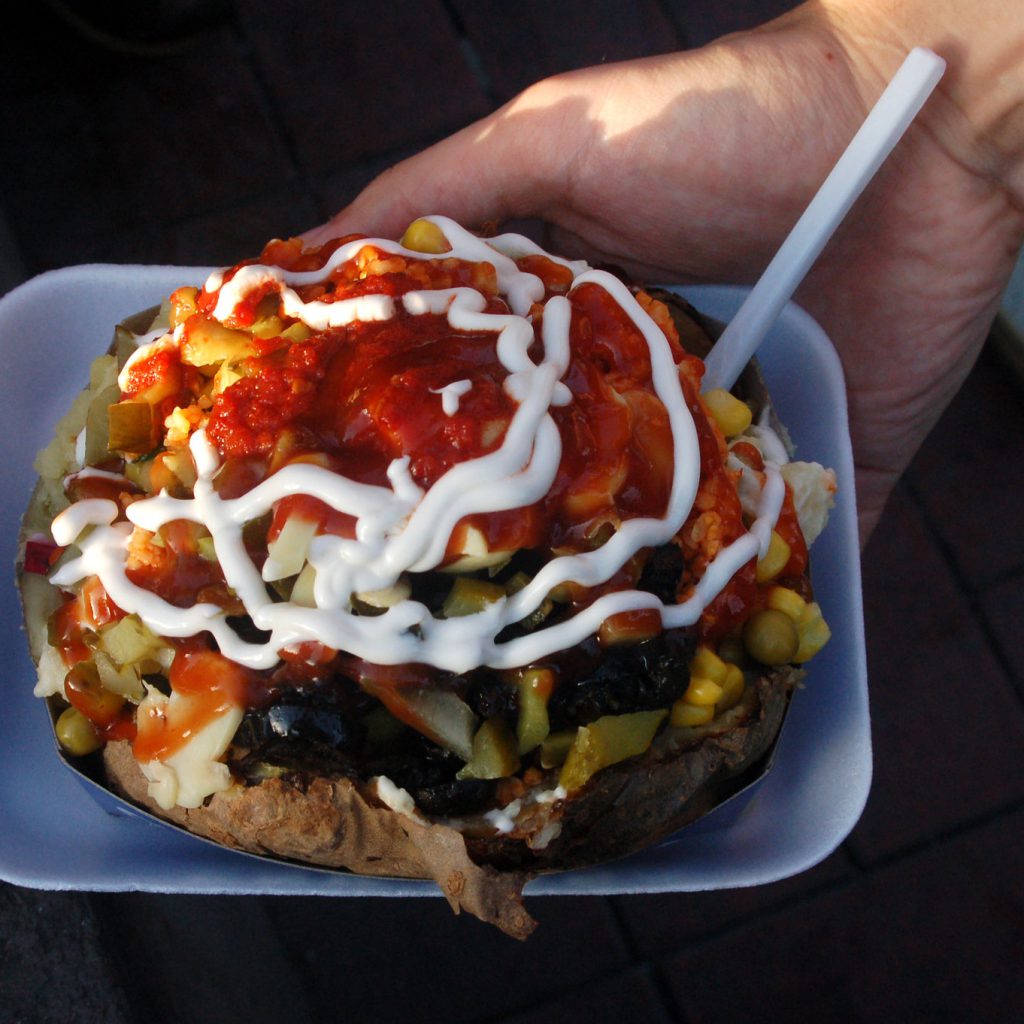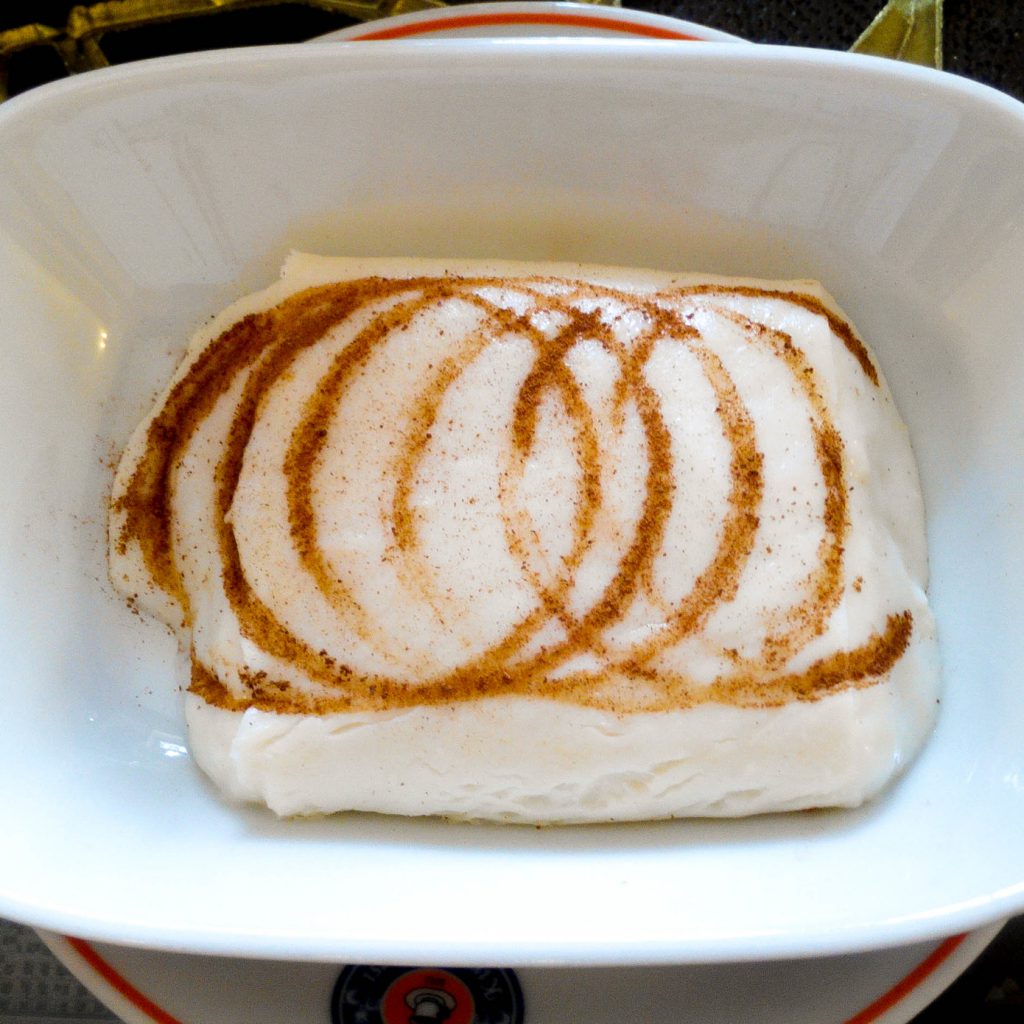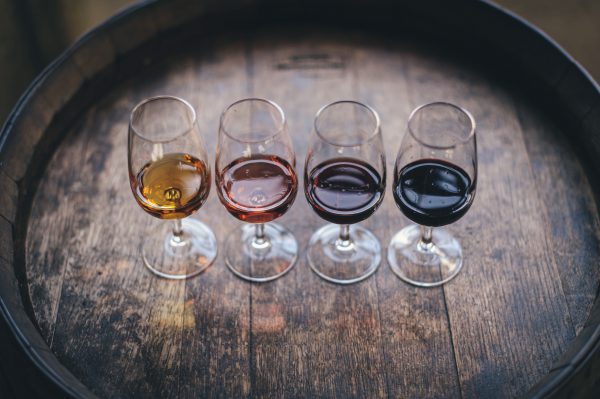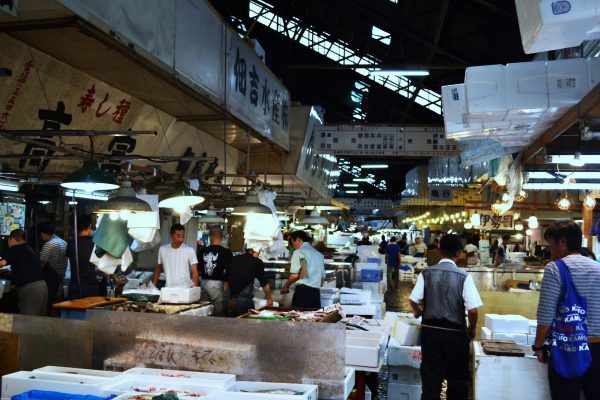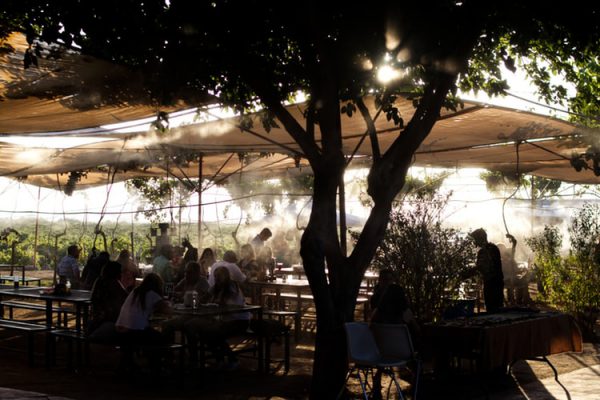Last Updated on December 23, 2022
Turkish cuisine is the heritage of an empire cuisine — namely, the Ottoman Empire – so it carries influences from different cultures and culinary traditions.
Even though Turkish cuisine is famous for its kebabs, it also features Mediterranean and Middle Eastern dishes, along with a wide range of pastries and sherbet desserts. You can eat your way through different regions and still find a dish that’s exotic and exciting. In this article, we have brought together the best Turkish delicacies you should try when you visit Turkey.
Turkish Breakfast
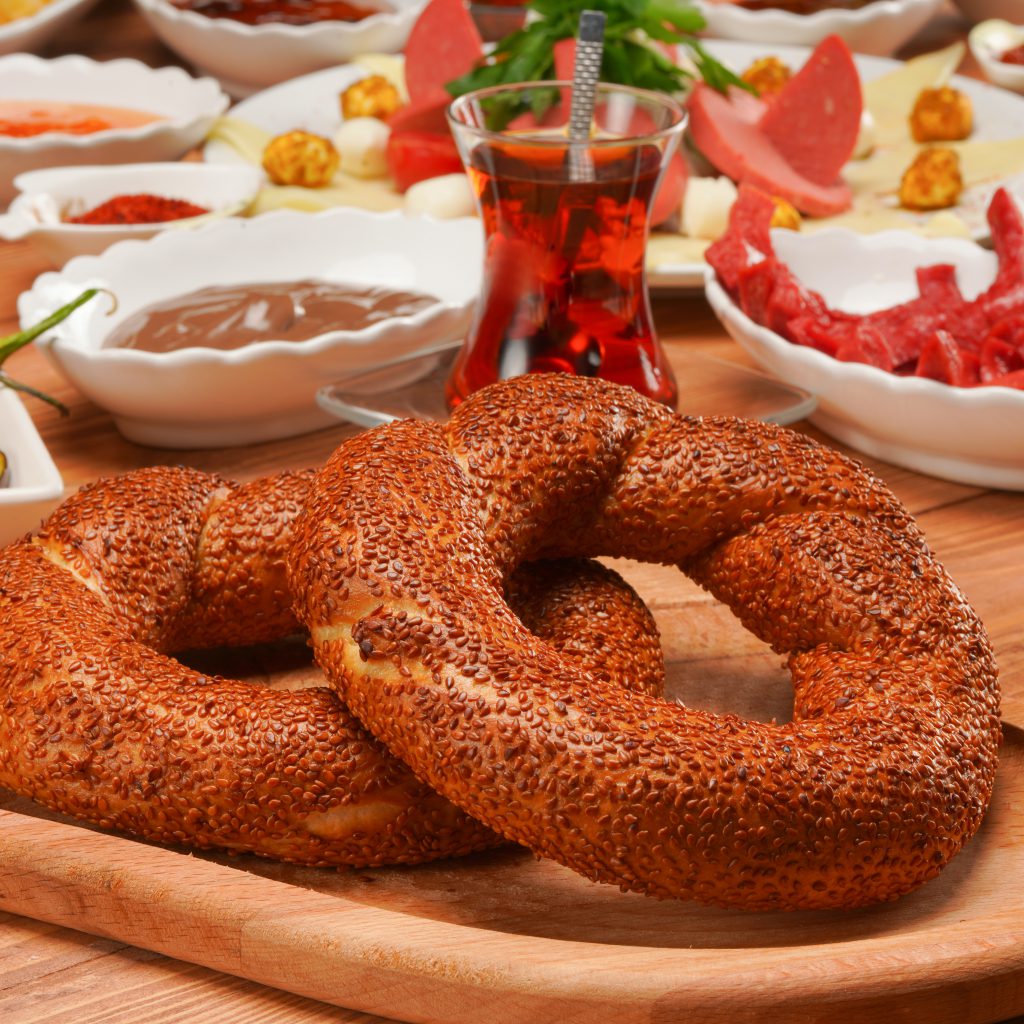
They say breakfast is the most important meal of the day, and Turks take it very seriously. Having a bowl of cereal or a piece of toasted bread in the morning is not acceptable in this country. The traditional Turkish breakfast — or, as they call it, serpme kahvaltı — is a full-on meal that fills the entire table.
When you order this dish, you get tomatoes, cucumbers, various kinds of cheese, green and black olives, egg dishes, cured meats, dips, sauces (cream, sweet butter, honey, and jam), and freshly baked bread or simit (a sort of bagel covered with sesame seeds). Of course, you also get freshly brewed çay (black tea). This is the minimum requirement for a traditional breakfast in Turkey.
The way people have breakfast in this country might surprise you, but it lays important clues about its food and culture. Turkish people prize their guests highly and love to host their friends and family and socialize around at the table. The Turkish word for breakfast is kahvaltı, which literally means “coffee base.” Having a cup of Turkish coffee after breakfast is quite common and keeps the conversation going.
If you’d like to prepare and enjoy a real traditional Turkish breakfast, check out this cooking class on Princess Island near Istanbul.
Now let’s look at some other classic breakfast dishes you can feast upon while you’re there.
Menemen

Menemen is a straightforward yet delicious dish made with scrambled eggs, chopped tomatoes, sliced green peppers, and sometimes chopped onions and spices. It’s a very harmonious meal where all flavors compliment each other perfectly. Scooping it with your bread or bagel is the best way to enjoy this affordable and loved-by-all breakfast delicacy.
Kuymak
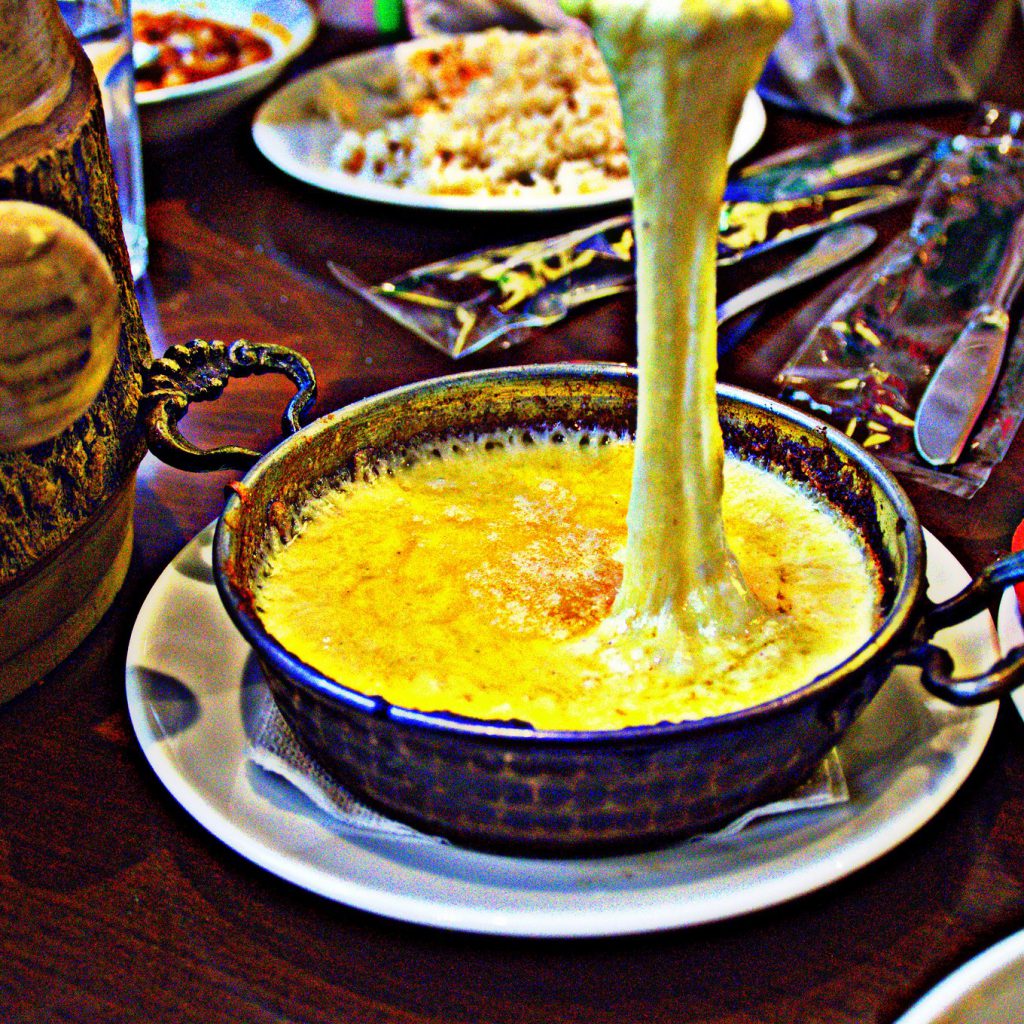
By Temay KIYMIK
Calorie counters, look away. Kuymak — also known as mıhlama — is a dish from the Black Sea region made from corn flour, cecil cheese (a special cheese from eastern Turkey), and butter. Like menemen, you can scoop it with your bread, but this time, you get to watch the melted cheese stretch all the way from the plate to your bite.
Kebabs
When discussing Turkish cuisine, the first dish that comes to mind is kebab. There are many types of kebab, and they’re all prepared by cooking red meat flavored with spices on the barbecue or in traditional ovens. Doner, adana, beyti, chokertme, urfa, skewer, cag, islim, and testi are just a few famous varieties, prepared using different veggies, spices, and herbs and cooked in different styles.
Doner Kebab
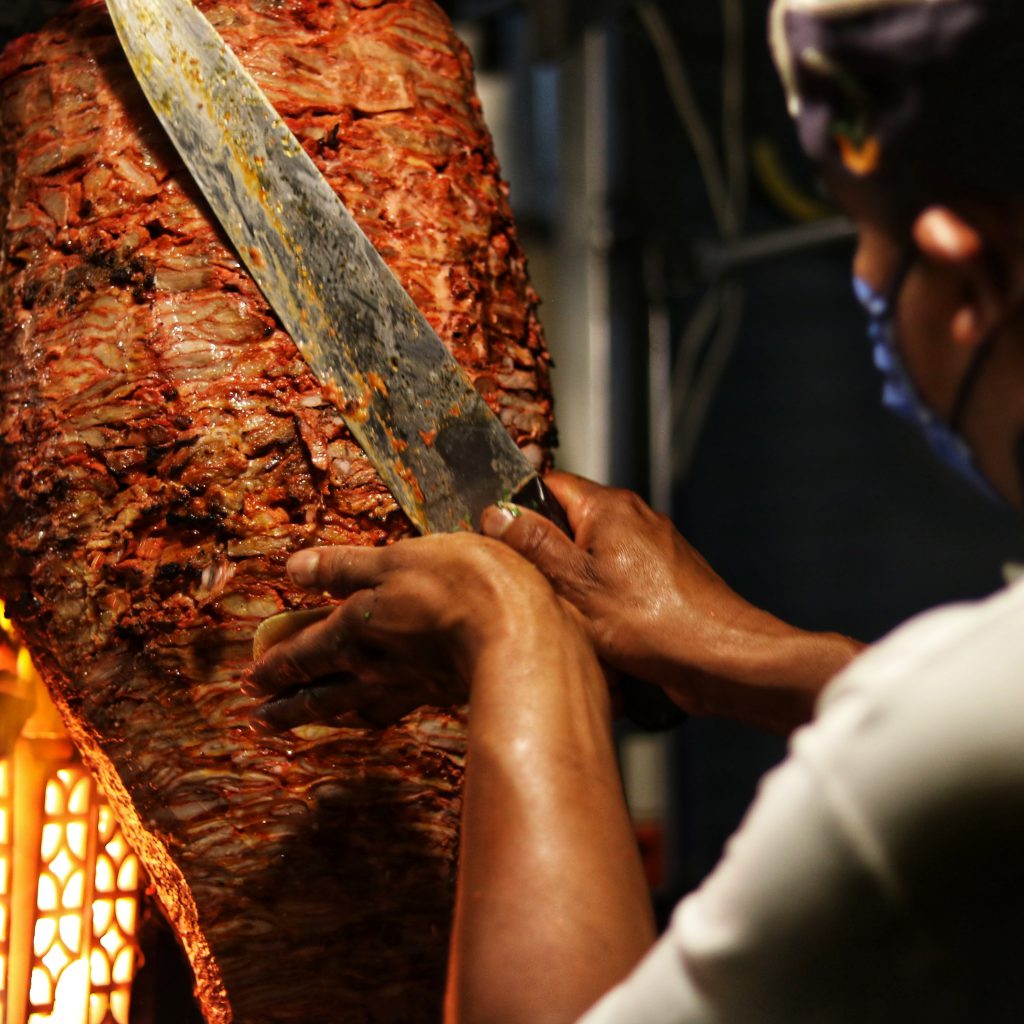
You might have had doner kebab someplace else already, as Turkish immigrants have made it a staple fusion dish in Germany and many other European countries. In Turkey, it’s a popular dish you can find on any street, busy or desolate.
The word doner literally means “something that rotates.” The dish is made by cooking red meat on a giant vertical rotisserie. The caramelized outer layer is shaved off as the chunk of meat rotates by the fire. You can have it served on a plate with pilaf, salad, and bread or as an on-the-go sandwich inside pita bread or wrapped in tortillas (dürüm) with lettuce salad, onions, and tomatoes.
Iskender Kebab
Iskender kebab is made with the same technique as doner kebab, but it’s heavier than doner, thanks to the extra butter and tomato sauce. It’s a famous type of kebab and takes its name after its inventor, Iskender Efendi, or Sir Alexander.
The caramelized meat slices are placed over bite-sized pita bread pieces and topped with hot tomato sauce and melted butter. Serving the dish with yogurt and roasted peppers is obligatory. If you like heavy dishes with lots of meat and fats, Iskender kebab can take you to a happy place.
Shish Kebab
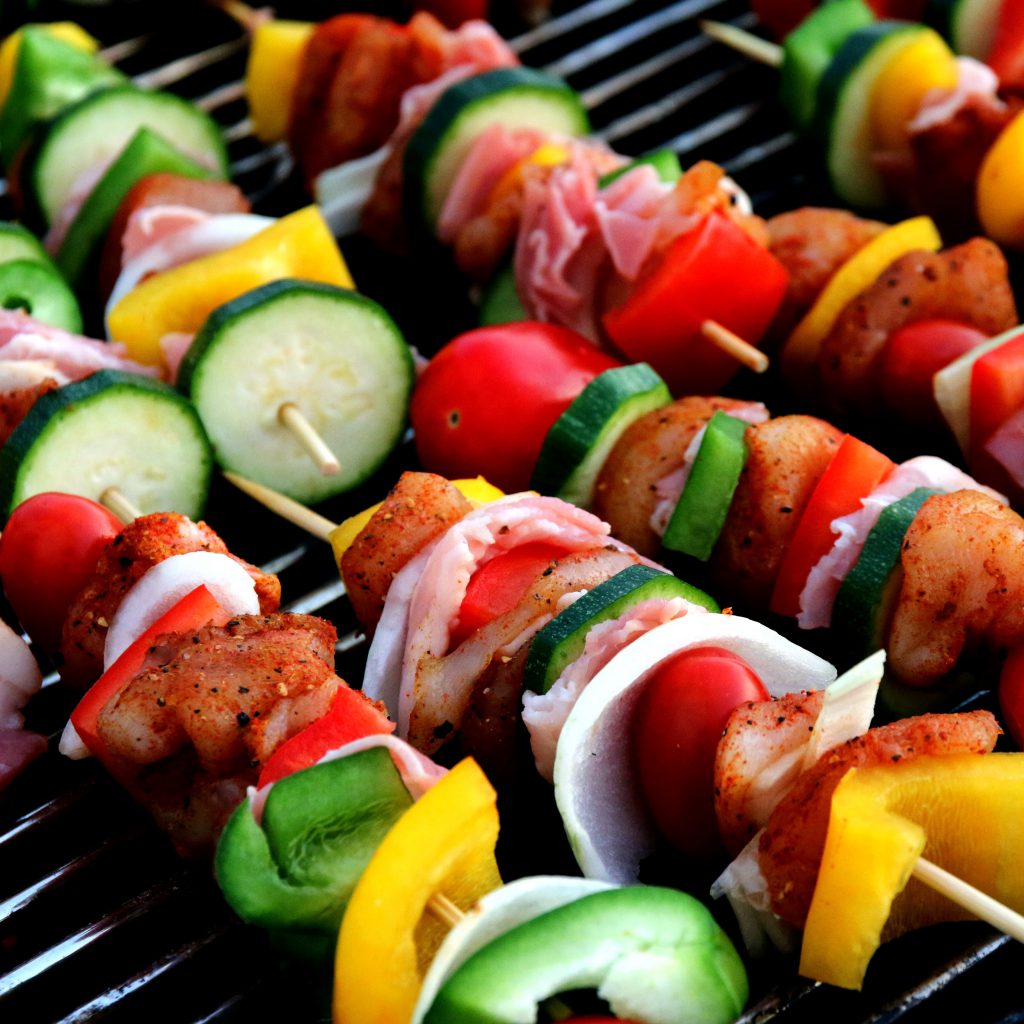
Shish means skewer in Turkish, which is exactly how shish kebab is served – by adding veggies such as eggplant, tomato, and pepper, and pieces of marinated beef or lamb meat on a skewer. The skewer is grilled on a barbeque to golden crispness.
What makes a shish kebab spectacular is the meat’s marinade, which is made with olive oil, onions, and lemon juice, although it can also include bay leaves, marjoram, cinnamon, allspice, and others that might be added depending on where you eat it.
Meze
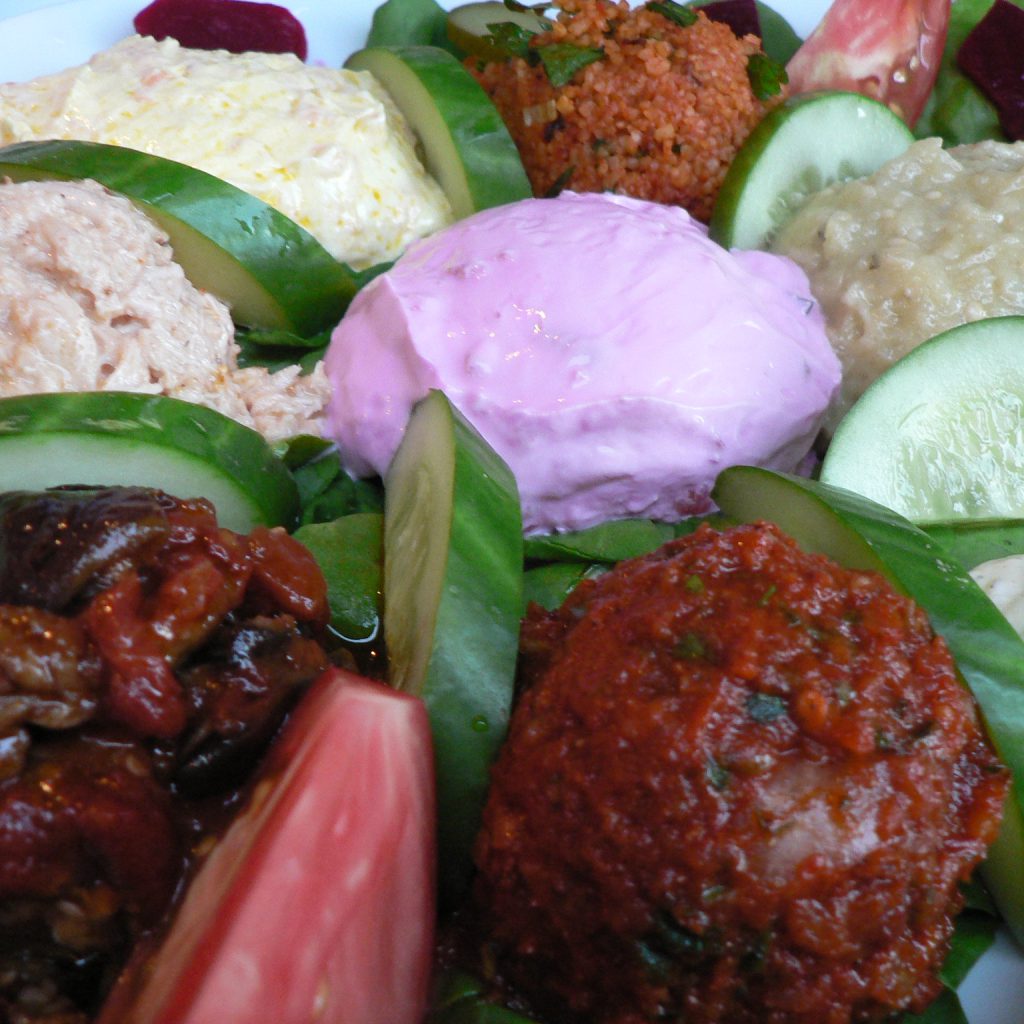
By John Morris
Putting aside the kebabs, we’re moving forward to some lighter dishes that’ll make the herbivores happy. Meze stands for various starters or side dishes, similar to Spanish tapas or Venezian cicchetti, made with seasonal ingredients.
Meze has an important place in Turkish culture. When you dine in a traditional restaurant, your table will be adorned with small meze dishes, even if you don’t order any yourself. The dishes typically include a wide variety of veggies, pastes, and salads. The varieties of meze can change depending on where you are since each region has its own signature meze.
Acılı ezme, meaning hot mash, is one such classic meze that resembles Mexican salsas. It is made with mashed onions, garlic, tomatoes, and green or red peppers. To that you add some lemon juice, olive oil, red pepper paste, pomegranate molasses, and a little bit of mint. As the name suggests, it can be quite spicy.
Another meze you should approach with caution is atom, made of hot red pepper grills mixed with garlicky yogurt. There’s also haydari, made of condensed yogurt, feta cheese, garlic, herbs like dill and mint, and olive oil.
You’ll also find meze centered around vegetables – especially roasted eggplant – such as şakşuka — also known as babaganoush in the Middle East — and köpoğlu. Then there’s hummus, bean salads like barbunya, or other vegetables like sea beans and purslane.
Kofte (Meatballs)
Kofte is a staple food in Turkey and is consumed even more than doner or Iskander kebab, so much so that every Turkish city has a landmark kofte recipe. Maybe it’s because this meaty dish is very simple to cook and pairs well with many things, from pilaf to vegetable dishes.
Kofte (just like Moroccan Kefta) means meatballs, but it’s not actually made of pure meat. It’s very similar to the Swedish meatballs — which are also based on a Turkish recipe. The classic version is made with minced beef, onions, eggs, breadcrumbs, spices like cumin, salt, red and black pepper, and chopped parsley. The mixture is kneaded like a dough and separated into cookie-like buns. Kofte can be shallow-fried, steam-fried, or both if you steam-fry it, let the water evaporate, and then shallow-fry it for some extra caramel action.
If you order kofte at a restaurant, you’ll get the classic kofte. But there are other recipes, such as kadınbudu kofte, which is also made of beef, eggs, and onions but also includes garlic, cooked rice flour, and spices. This kofte is deep-fried and served with yogurt.
There’s also inegol kofte, made with lamb meat and baking soda, and içli köfte, which resembles huge dumplings with a meaty mixture swaddled by a thin layer of bulgur. These are some of the most common köfte types you can have in Turkey, but we assure you, the list goes on and on.
Lahmacun
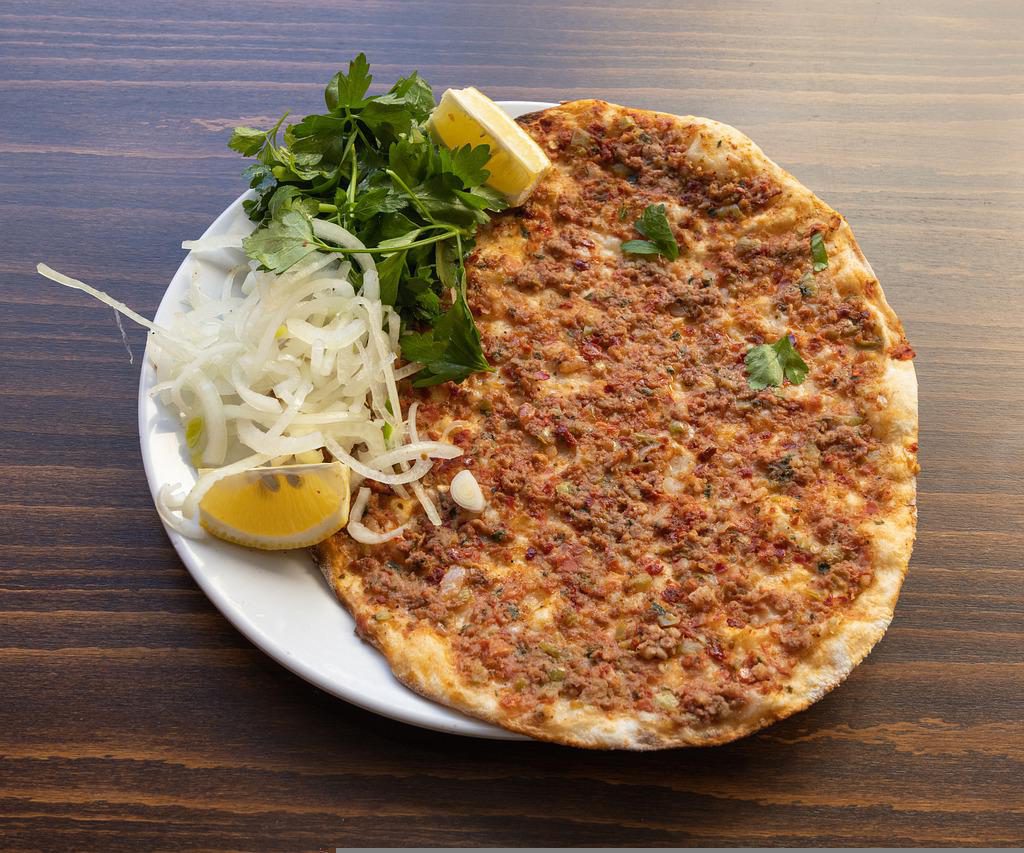
Middle Eastern cuisine is famous for its flatbreads. Moroccans have msemen, Iranians have taftoon, and lahmacun is a favorite among Turks and Armenians.
Pronounced as lah-mah-june, lahmacun resembles pizza in appearance, but the crust is super thin, and it’s always topped with a mixture of really finely minced beef or lamb meat, onions, peppers, tomatoes, and lots of spices. You can order it either hot (acılı) with Aleppo chili or mild (acısız).
Lahmacun is baked in a wood-burning stone oven. You can eat it any way you like, but the locals would typically top their lahmacun with parsley, onions, and lemon juice and roll it into a wrap.
Mantı
Some call mantı the Turkish ravioli, but they’re so much more than that. These tiny dumplings are stuffed with minced meat, onions, and spices. They actually look like tiny gyozas, but mantı’s stuffing is much simpler, and it’s always cooked in boiling water.
It’s said that Mongol horsemen brought the dish to Anatolia from Middle Asia in the 13th century, where it became a palace recipe for the Ottoman dynasty. Today, it’s a widely enjoyed dish all over Turkey.
Making mantı at home is a tedious job that can take hours if you’re not experienced. That’s why Turks usually buy it ready-made or make it for social occasions.
Mantı begins with a simple dough made of flour, salt, water, and eggs. The ingredients are foolproof, but the dough needs to be rolled until it’s very thin. Then it’s cut into little rectangles, only about a few centimeters, to be filled with the stuffing mixture and folded into small bundles one by one. Then all the bundles are boiled in salty water. If you want to try your hand at making manti, you can join this best of classics cooking class, where you’ll learn how to make it along with several other traditional dishes.
The size of the mantı you eat can differ from place to place, but a Turkish urban legend says that the perfect mantı should be so small that 40 of them can fit in only one spoon. We don’t know if it’s true, but you will have ample opportunity to see for yourself on your visit.
After cooking, the dumplings are served with butter paprika or tomato sauce and yogurt. You can season with sumac and dried mint leaves for an extra authentic manti experience.
Stuffed Grape Leaves (Yaprak Sarma)
There are two versions of stuffed grape leaves or yaprak sarması. One is made of meat and is a full-on meal served with yogurt. The other option is vegetarian and can be eaten cold, like a meze.
Both versions start by boiling the grape leaves. The stuffing for the meze version (zeytinyağlı yaprak sarması) includes olive oil, onions, rice, pine nuts, currant, cinnamon, black pepper, mint, allspice, and salt. The meaty version includes minced meat, rice, onions, fresh mint, parsley, pepper and tomato pastes, olive oil, black pepper, and salt. The stuffing is rolled into individual leaves, like Cuban cigars, and the rolls are steam-cooked in a lidded pot.
Dolma
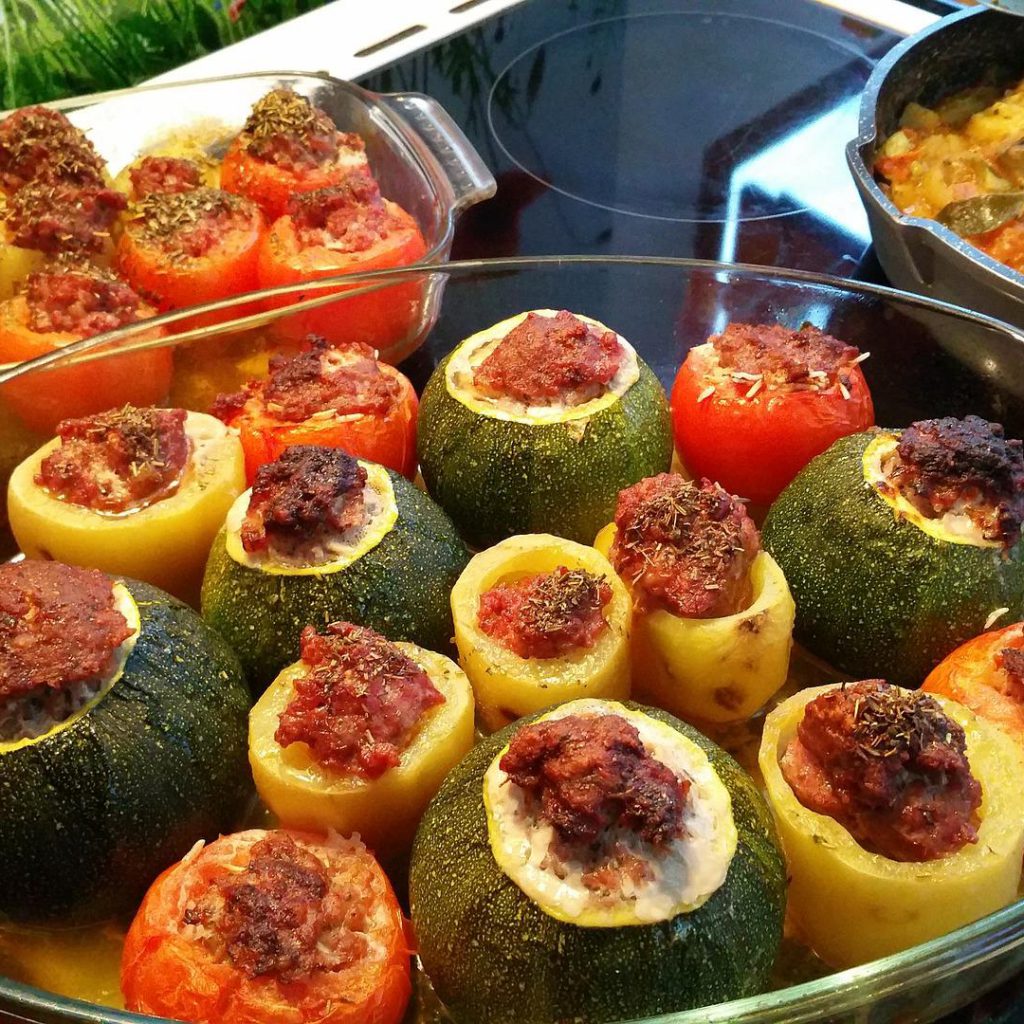
Dolma is another staple food that an average Turkish person grows up eating once a week. It’s also very common in the Balkans, Southern Caucasus, Middle Asia, Mediterranean, Aegean, and Middle Eastern cuisines. If you’ve never had dolma before, take these rooted cultures as a reference and give it a try.
The recipe is similar to the stuffed grape leaves one, and you’re about to see why. As we just said, the word dolma literally means stuffed, and the recipe consists of stuffed vegetables, usually zucchinis, eggplants, various kinds of peppers, and even zucchini flowers.
The stuffing is rich and savory and includes rice, minced meat, garlic, onions, tomatoes, parsley, paste, pepper paste, and various spices. You hollow out the veggies, stuff them, and then steam-cook the dolmas in a lidded pot, just like the stuffed grape leaves.
Hünkar Begendi
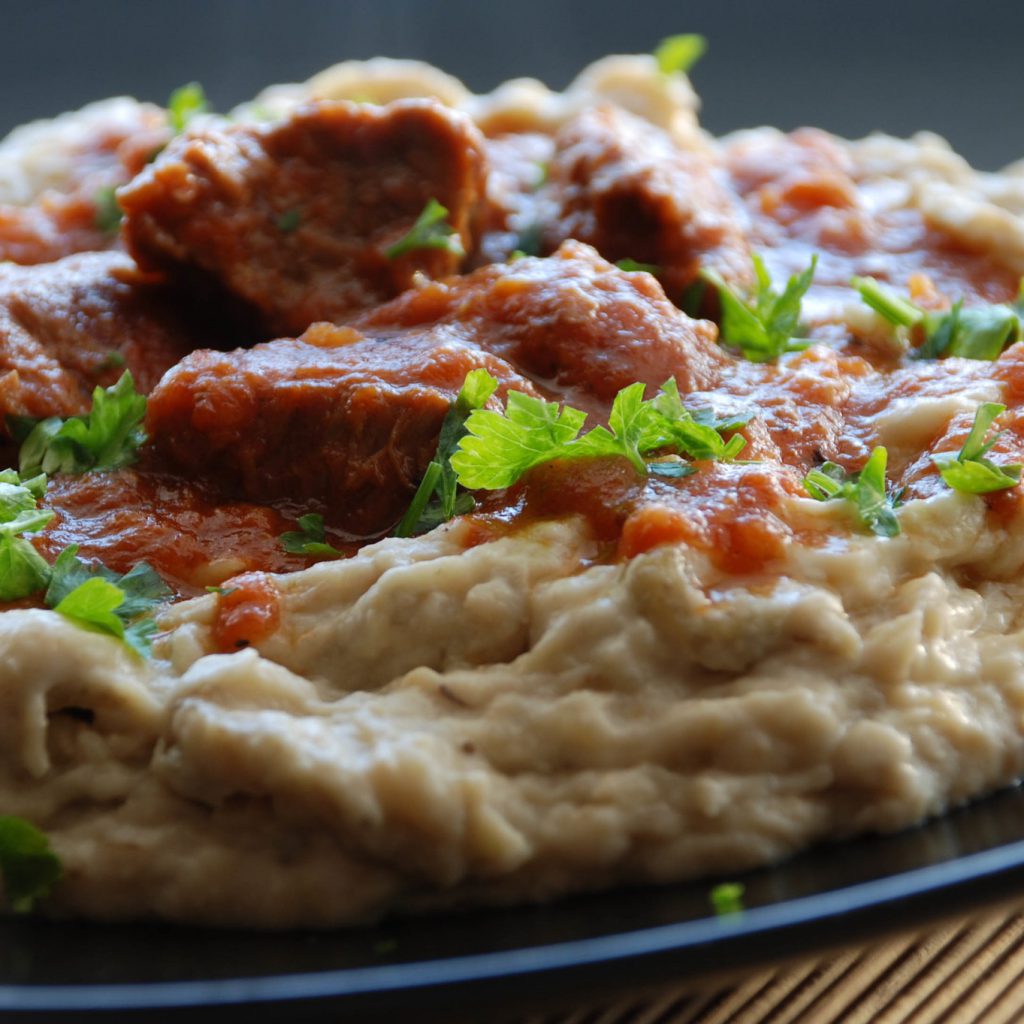
By Gio
As we talked about at the beginning, Turkish cuisine incorporates many different traditions and cultures. Hünkar Beğendi is a classic lamb dish, one of the most popular dishes among the palace recipes on the Sultan’s diet.
The name literally translates to “sultan likes” — yes, Turks have many creative choices when it comes to naming dishes — and is one of the landmarks of Turkish cuisine. It consists of a creamy puree-like base made of roasted eggplants, cheese, butter, flour, milk (similar to bechamel sauce), and spices such as nutmeg and black pepper. Then this delicious puree is topped with a healthy lamb meat sautee.
While most palace dishes are not very popular in Turkey due to their complexity, hünkar beğendi is a very simple dish to make (though, like many dishes from Turkey, probably not so simple to master). If you want to learn how to make hünkar beğendi and other palace recipes, you can join the Alaturka cooking classes to try your hands at some of the most popular Ottoman dishes.
Kumpir
Another street food legend from Turkey, kumpir, is a dish originating in Yugoslavia (where it’s called krumpir) and is thought to be brought to Turkey by immigrants displaced by the union’s dissolution. People in Turkey love this potato dish and have made it their own through the years. Today it’s a prevalent street food that you can find anywhere and everywhere in the country.
Kumpir is a baked potato dish that features many toppings. The baked potato is cut in half with skin on. Then the softened potato inside is thoroughly mixed with butter and grated cheese until the texture is gooey and creamy. You garnish it with assorted toppings, such as corn, seedless olives, pickles, russian salad, chopped sausage, salami, ketchup, and mayo.
Tavuk Göğsü
Moving along to the desserts, tavuk göğsü is guaranteed to mesmerize you at first bite. We are thankful to the Ottoman palace chefs for this out-of-this-world pudding. Tavuk göğsü means chicken breast, but this time it’s not just a quirky misplaced name; this dessert actually contains raveled chicken breasts to give it consistency.
Tavuk göğsü is quite fresh and light to taste, almost like a rice pudding. But what makes this dessert unique is its texture, which is sticky and stringy from the fibrous chicken meat. But don’t worry, there’s not even the slightest taste of poultry in the dessert. Even people from Turkey are surprised when they learn there’s actual chicken in it.
Künefe
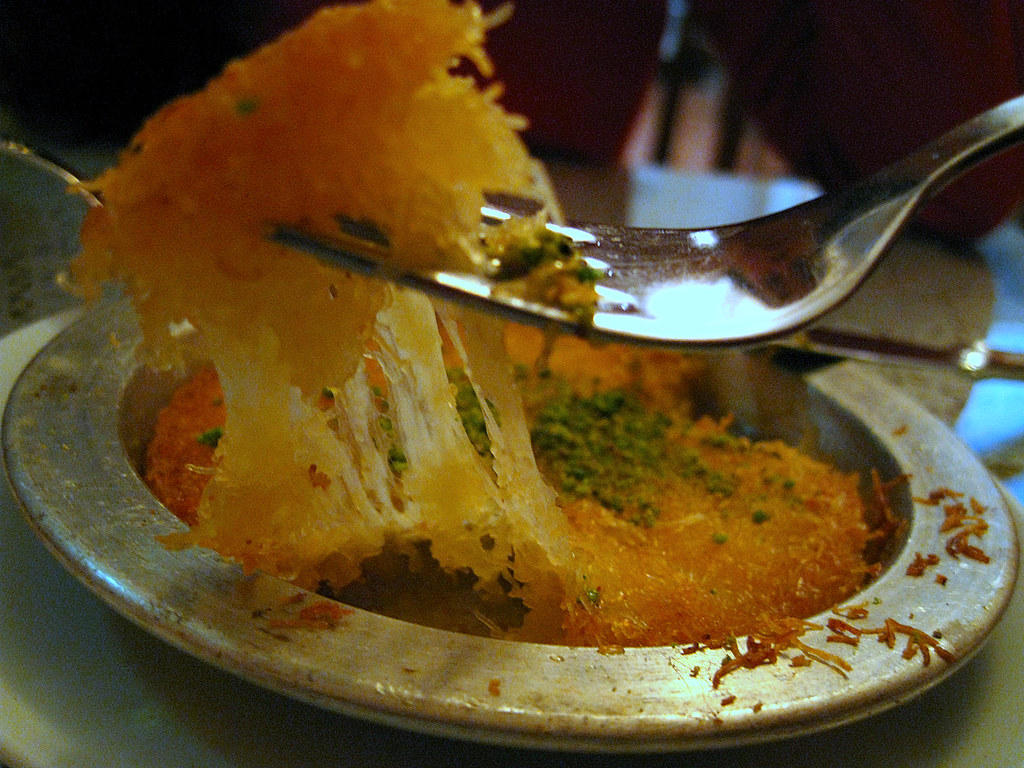
By Ryan
Coming from the Southern regions of Turkey, künefe is a rambunctious desert that combines sweet with savory. Künefe has 5 main ingredients: kadayıf, a finely shredded phyllo dough. Next, there’s the unsalted, stringy cheese, similar to mozzarella. You also have the syrup or sherbet, as Turks call it. Finally, some melted butter and ground pistachio on top.
The shredded phyllo dough is wrapped around the cheese and bathed with melted butter. They are cooked in a small portion tray until the top layer gets caramelized. When cooked to perfection, the dessert is bathed in syrup and topped with ground pistachios.
As you see, künefe is a real indulgence with all its sinful ingredients. The syrup and melted butter satisfy both your sweet and savory tooth, and every bite of the gooey cheese is guaranteed to take you to heaven.
One thing to remember is that a portion of künefe is almost always too much for one person, so it’s the perfect dessert for sharing. You can wash it down with milk, tea, ice cream, or kaymak — a type of cream made of skimmed milk, and get your palette ready for even more künefe.
Güllaç
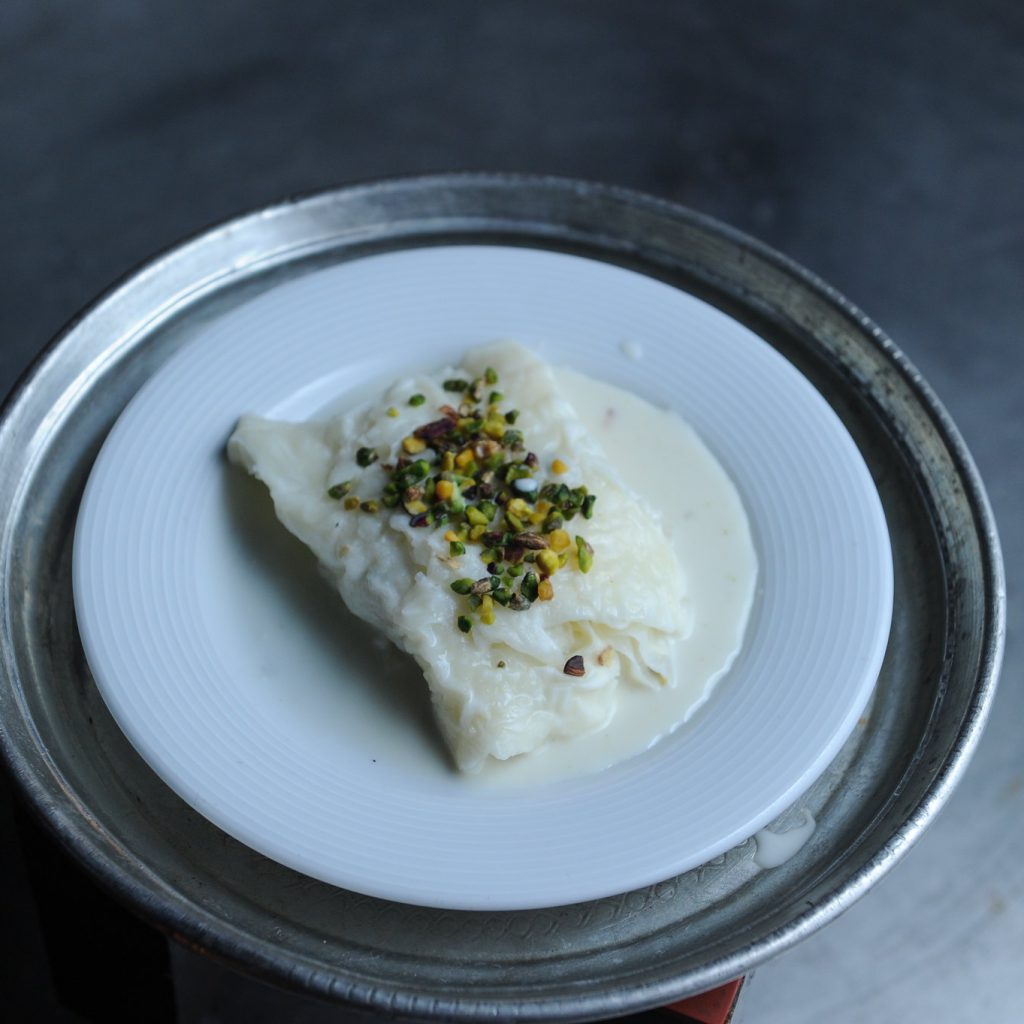
By Armada Hotel
Güllaç is the most delicious proof that great things can be achieved with a few simple ingredients. Its primary ingredients are cornstarch, flour, milk, various nuts, and pomegranate. The cornstarch is made into a dough, spread thinly, and dried in an effort to preserve it. Layers of paper-thin cornstarch wafers are soaked with sweetened milk and rose water and garnished with ground walnuts, pistachios, hazelnuts, and pomegranate seeds.
Güllaç was invented nearly half a millennium ago in the Ottoman Empire. According to a legend, a chef in Kastamonu created this dessert for royal guests on a trip. Visitors loved güllaç so much that it quickly became a palace recipe and granted the chef a place in the palace kitchen.
It’s a dessert enjoyed during the holy month of Ramadan, which Muslims celebrate worldwide. If you’re visiting Turkey during Ramadan, make sure you try this delicacy.
Baklava
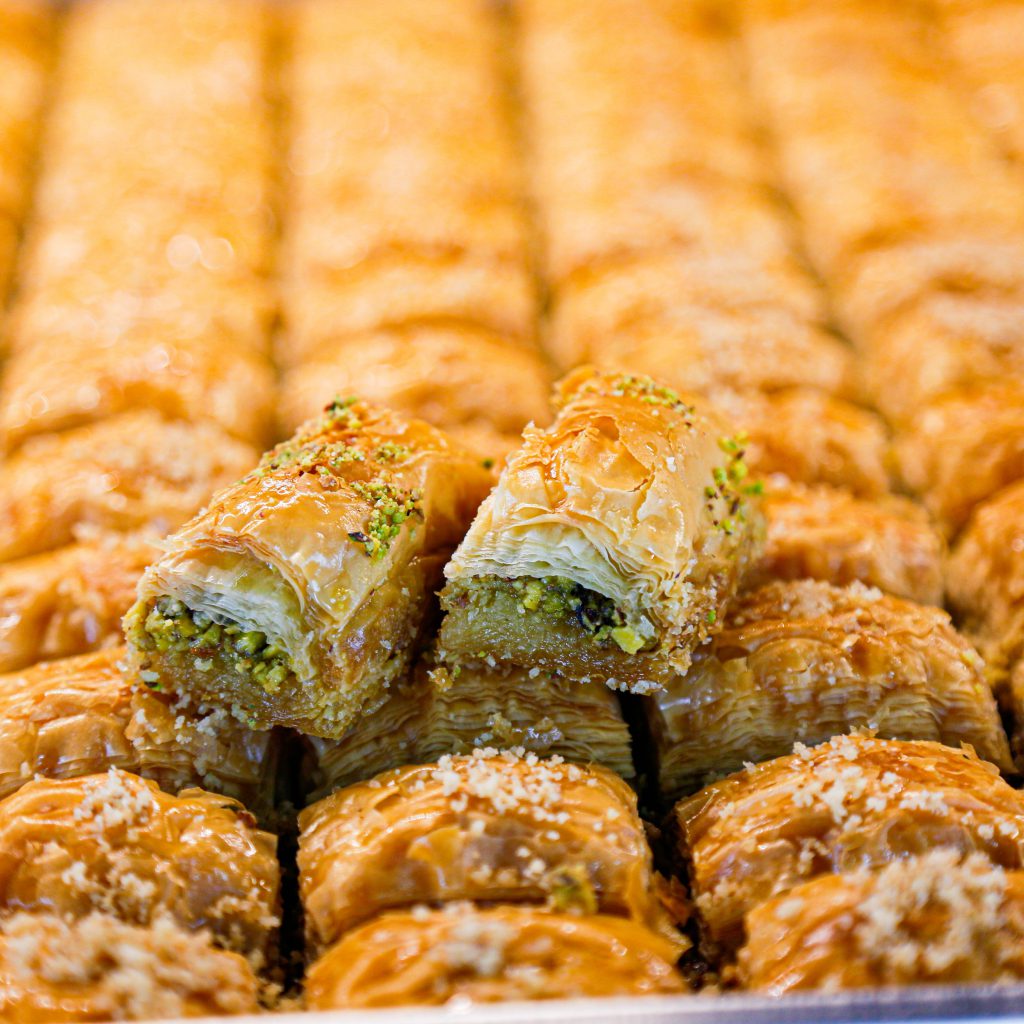
The traces of this layered sherbet dessert can be traced back to the Assyrian Empire, which ruled during the 8th century BC in today’s regions of South Eastern Turkey, Iraq, Syria, and a part of Egypt. Many Mediterranean countries have a version of this dessert with their twist.
Regardless of the dish’s first origin, you can have phenomenal baklava in Turkey, especially in the South East region. The staple ingredients are incredibly thin phyllo leaves, honey-based sherbet, butter, and nuts (typically walnuts or pistachios). The dessert is made by brushing the paper-thin phyllo leaves with butter and topping them with nuts layer by layer. Sherbet is poured over the whole thing after it’s baked to ultimate crispiness. And the result is a very satisfying sweet with a phenomenal texture and taste.
While the real deal requires an intense mastery that’s passed from the master to the apprentice in years of training, you can learn to make homemade baklava yourself. If you’re interested, check out this homemade baklava workshop in Istanbul or this touristic Istanbul tour with baklava workshop.
Sahlep

If you’re in Turkey in winter, we have the perfect drink recommendation for you. Sahlep is a drink made from the dried roots of a special kind of orchid and milk. The drink is prepared by cleaning, boiling, drying, and grounding the orchid tubers into fine powder. Then, you boil the powder with milk to make a cup of hot sahlep.
You would sprinkle some cinnamon powder or ground nuts on top. It’s a thick and aromatic drink that’ll warm you from the inside. Its taste resembles that of vanilla, but it has its own profile, so you have to try it for yourself to really see what makes it special. Make sure to avoid the instant sahlep powders as they usually contain only sahlep flavoring rather than the real deal.
Maraş Ice Cream

By ericahlberg
If you think the best ice cream in the world is made in Italy, we beg to differ. Maraş — pronounced ma-rush — is a dense and intense ice cream made of goat milk, sugar, sahlep, and sometimes gum mastic. The ice cream takes its name from the city of Kahramanmaraş.
Summertime in Turkey feels like an ice cream festival. You can have it on a cup, a cone, on a wafer called kağıt helva, or even served as a side with most desserts like tavuk göğsü, baklava, or künefe.
If you choose to get a cone of maraş ice cream from a stall, you’ll be in for a series of tricks and treats. These cheeky ice cream men make the cone slip through your hands and pass a scoop of ice cream from one cone to another while you try to catch it.
Güle Güle!
Here we listed some of the dishes you have to try on your visit to Turkey. The country is overflowing with history and culture, and all the regions have different local cuisines and staple foods.
If you think scratching the surface isn’t enough, one of the best things you can do is to try your hands at a cooking class. You can always check out all the cooking classes in Turkey to see which one suits your interests and location the best.


